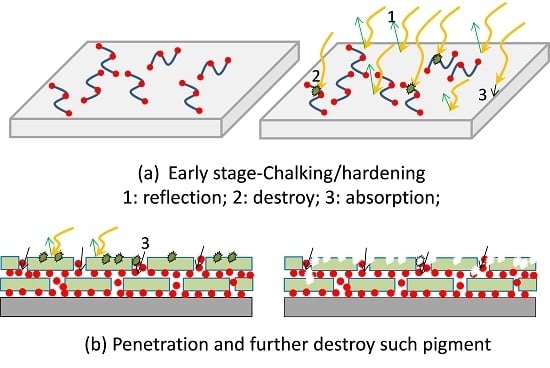Deterioration of Basic Properties of the Materials in FRP-Strengthening RC Structures under Ultraviolet Exposure
Abstract
:1. Introduction
2. Materials and Methods
2.1. Preparation of the Specimens
2.2. Test Methods
3. Results and Discussions
3.1. FRP Sheet Specimens
3.1.1. Physical Changes
3.1.2. Effect of Variables on Mechanical Properties
3.2. Resin Adhesive Materials
3.2.1. Effect of Variables on Mechanical Properties of Resin Adhesive Materials
3.2.2. Concrete Compressive Strength
3.2.3. SEM Analysis-Microstructural Development of Concrete
3.2.4. XRD Analysis-Hydration Effect of Concrete
4. Deterioration Mechanism
- When the fibre composite materials are irradiated by UV radiation, the resin adhesive materials on their surface firstly contact the radiation waves, and the resin molecules absorb the high-energy light wave to produce the photo-aging reaction which makes the materials turn yellow and leads to cracking. However, at the early stage, the overall mechanical characteristics of some FRP specimens may also be improved due to the low-degree volumetric shrinkage or the hardening of resin adhesive materials at the early stage. It is also possible that the main intermolecular bonding energy in some resins is from some stable chemical bonds (Figure 18a).
- As the wavelength of ultraviolet light is small and quite poor in its penetrative ability, most of the radiant energy can only affect the surface of resin adhesive materials. Only a small amount of longer radiation energy of the ultraviolet radiation can destroy the surface, so the damage of fibre reinforced materials is much lower than the damage to the resin materials. However, as shown in Figure 18a, the chalking of resin happened on the surface and the cracking was extended.
- With UV exposure, for more UV lights to enter and touch FRP sheet, a large number of molecular bonds were then destroyed, which leads to decreases in the strength and module of these FRP sheets. The reason for the decreased strength of FRP material after ultraviolet radiation is that the capacity and effectiveness of the stress transmission between FRP materials or between resin adhesive and FRPs are reduced, which is caused by the further decrease in the strength and modulus of resin adhesive materials or its pulverization due to longer UV radiation exposure (Figure 18b).
- In a typical strengthening of the damaged RC structure, limited UV lights can reach the concrete–FRP interface zone; the effect of UV exposure on the bond degradation between FRP and concrete should be theoretically very small. More detailed studies should be conducted in the future to evaluate the effect of UV exposure on the bond degradation between FRP, resin adhesive layer and concrete.
5. Concluding Remarks
- UV exposure has a different influence on the basic properties of different FRP sheets. Based on this study, among the four types of FRP sheets, CFRP has the most stable mechanical properties after UV exposure. The basic properties of BFRP were affected significantly by UV exposure and are lower than those of other FRP sheets.
- Based on this study, the increase of the number of FRP layers cannot reduce the effect of UV exposure on the basic mechanical behavior of FRP sheets, which is partly attributed to the instability between the FRPs and adhesive layers. However, more research on the number of FRP layers on the UV effect in the FRP–concrete interface zone, such as the bond behavior, is expected in the future.
- The material properties of adhesive can effectively determine the FRP-strengthening of RC structures through affecting the degradation of FRP sheets. The degradation of the mechanical properties of FRP sheets due to UV exposure can be different when different adhesive materials are used.
- In the initial stage, the mechanical properties of some FRP sheet specimens are improved which is due to the low-degree volumetric shrinkage or hardening and internal status change of resin adhesive material, improving the mechanical characteristics of the resin adhesive and FRP. However, the main intermolecular bonds in the resins at the early stage are more stable and are also one of the reasons for the improvement.
- The effects of UV exposure on the tensile strength and module properties of different resin adhesive materials are different. Additionally, the study implied that the UV exposure time leading to the property degradation is different when different resin materials were used.
- FRP can provide a reinforcement action to the properties of resin adhesive materials due to the effect of UV exposure starting from the surface of resin adhesive materials.
- The compressive strength of concrete was improved after UV exposure in the chamber having a certain humidity and temperature, which indicated that it may be helpful to concrete strength development when the concrete is under the three environmental effects.
- Based on the SEM and XRD analyses, after UV exposure, the physical microstructure of concrete was improved and more strength-favorable chemical compositions were produced in the concrete.
Acknowledgments
Author Contributions
Conflicts of Interest
References
- Andrady, A.L.; Hamid, S.H.; Hu, X.; Torikai, A. Effects of Increased Solar Ultraviolet Radiation on Materials. J. Photochem. Photobiol. B Biol. 1998, 46, 96–103. [Google Scholar] [CrossRef]
- Bae, S.W.; Belarbi, A. Effects of various environmental conditions on RC columns wrapped with FRP sheets. J. Reinf. Plast. Compos. 2010, 29, 290–309. [Google Scholar] [CrossRef]
- Baghi, H.; Barros, J.A. Shear strengthening of reinforced concrete T-beams with hybrid composite plate. J. Compos. Constr. 2016, 20, 04016036. [Google Scholar] [CrossRef]
- Jiang, T.B.; Li, M.; Sun, Z.J. Bond strength of CFRP/concrete under ageing condition. Fibre Reinf. Plast. Compos. 2002, 3, 7–10. (In Chinese) [Google Scholar]
- Chin, J.W.; Aouadi, K.; Nguyen, T. Effects of environmental exposure on fibre-reinforced plastic (FRP) materials used in construction. J. Compos. Technol. Res. 1997, 19, 205–213. [Google Scholar]
- Kato, Y.; Mishimura, T.; Uomoto, T. The effect of ultraviolet rays to FRP rods. In Proceedings of the 1st Conference on Durability of FRP Composites for Construction (CDCC’98), Sherbrooke, QC, Canada, 5–7 August 1998; pp. 487–497. [Google Scholar]
- Larsson, F. The effect of ultraviolet light on mechanical properties of Kevlar 49 composites. J. Reinf. Plast. Compos. 1986, 5, 19–22. [Google Scholar] [CrossRef]
- Gu, X.F. Durability Study of the Concrete Components Bonded with BFRP Composite Sheets under Ultraviolet Light. Master’s Thesis, Qingdao Technological University, Qingdao, China, 2010. (In Chinese). [Google Scholar]
- Aldajah, S.; Al-omari, A.; Biddah, A. Accelerated weathering effects on the mechanical and surface properties of CFRP composites. Mater. Des. 2009, 30, 833–837. [Google Scholar] [CrossRef]
- Yang, Y.X.; Guo, C.H.; Cai, P.; Zhao, Y.; Yue, Q. Effect of ultraviolet light on CFRP concrete bond property. Ind. Constr. 2006, 36, 18–20. (In Chinese) [Google Scholar]
- Yang, Y.X.; Wang, J.; Zhang, X.D. Study on durability of concrete structures strengthened by CFRP. Port Technol. 2002, 2, 25–27. (In Chinese) [Google Scholar]
- Hulatt, J.; Hollaway, L.; Thorne, A. Preliminary investigations on the environmental effects on new heavyweight fabrics for use in civil engineering. Compos. Part B Eng. 2002, 33, 407–414. [Google Scholar] [CrossRef]
- Garcia, K.; Hayes, M.D.; Verghese, N.; Lesko, J.J. The effects of cyclic moisture aging on a glass/vinyl ester composite system. In Progress in Durability Analysis of Composite Systems-International Conference; AA BAlkema: Blacksburg, VA, USA, 1998; Volume 173. [Google Scholar]
- Woo, R.S.; Chen, Y.; Zhu, H.; Li, J.; Kim, J.K.; Leung, C.K. Environmental degradation of epoxy–organoclay nanocomposites due to UV exposure. Part I: Photo-degradation. Compos. Sci. Technol. 2007, 67, 3448–3456. [Google Scholar] [CrossRef]
- Robert, M.; Cousin, P.; Fam, A.; Benmokrane, B. Effect of the addition of modified mica on mechanical and durability properties of FRP composite materials for civil engineering. Polym. Compos. 2011, 32, 1202–1209. [Google Scholar] [CrossRef]
- Yan, L.; Chouw, N.; Jayaraman, K. Effect of UV and water spraying on the mechanical properties of flax fabric reinforced polymer composites used for civil engineering applications. Mater. Des. 2015, 71, 17–25. [Google Scholar] [CrossRef]
- Bian, J.L.; Chen, B.K. Study of weather resistance of the fibre reinforced plastics. J. Qinghai Univ. Nat. Sci. 2007, 25, 7–9. (In Chinese) [Google Scholar]
- Ren, H.T.; Wang, A.K.; Hu, A.N. Durability of reinforced concrete structures strengthened with fibre reinforced plastic. In Proceedings of the Second Session of the National Civil Engineering Fibre Reinforced Composites Applied Technology Symposium, Beijing, China, 2002; Tsinghua University Press: Beijing, China, 2002. [Google Scholar]
- Zhou, J. Study on the Durability of GFRP Tube Concrete Columns under the UV Irradiation. Master’s Thesis, Zhejiang University of Technology, Hangzhou, China, 2015. [Google Scholar]
- Chinese Test Standard. Carbon Fibre Laminate for Strengthening and Restoring Structures; GB/T 21490-2008; Chinese Test Standard: Beijing, China, 2008. (In Chinese) [Google Scholar]
- EN ISO 4892-2. Plastics. Methods of Exposure to Laboratory Light Sources. Part 2: Xenon-arc Lamps; European Committee for Standardization: Brussels, Belgium, 2006. [Google Scholar]
- Chinese Test Standard. Test Methods for Porperties of Resin Cast Boby; GB/T 2567-2008; Chinese Test Standard: Beijing, China, 2008. (In Chinese) [Google Scholar]
- Schneider, L.F.J.; Cavalcante, L.M.; Silikas, N. Shrinkage stresses generated during resin-composite applications: A review. J. Dent. Biomech. 2010, V2010, 14. [Google Scholar] [CrossRef] [PubMed]
- Wang, R.M.; Zheng, S.R.; Zheng, Y.G. Polymer Matrix Composites and Technology; Elsevier: Amsterdam, The Netherlands, 2011. [Google Scholar]
- Chattopadhyay, D.K.; Panda, S.S.; Raju, K.V.S.N. Thermal and mechanical properties of epoxy acrylate/methacrylates UV cured coatings. Prog. Org. Coat. 2005, 54, 10–19. [Google Scholar] [CrossRef]
- Signor, A.W.; VanLandingham, M.R.; Chin, J.W. Effects of ultraviolet radiation exposure on vinyl ester resins: Characterization of chemical, physical and mechanical damage. Polym. Degrad. Stab. 2003, 79, 359–368. [Google Scholar] [CrossRef]
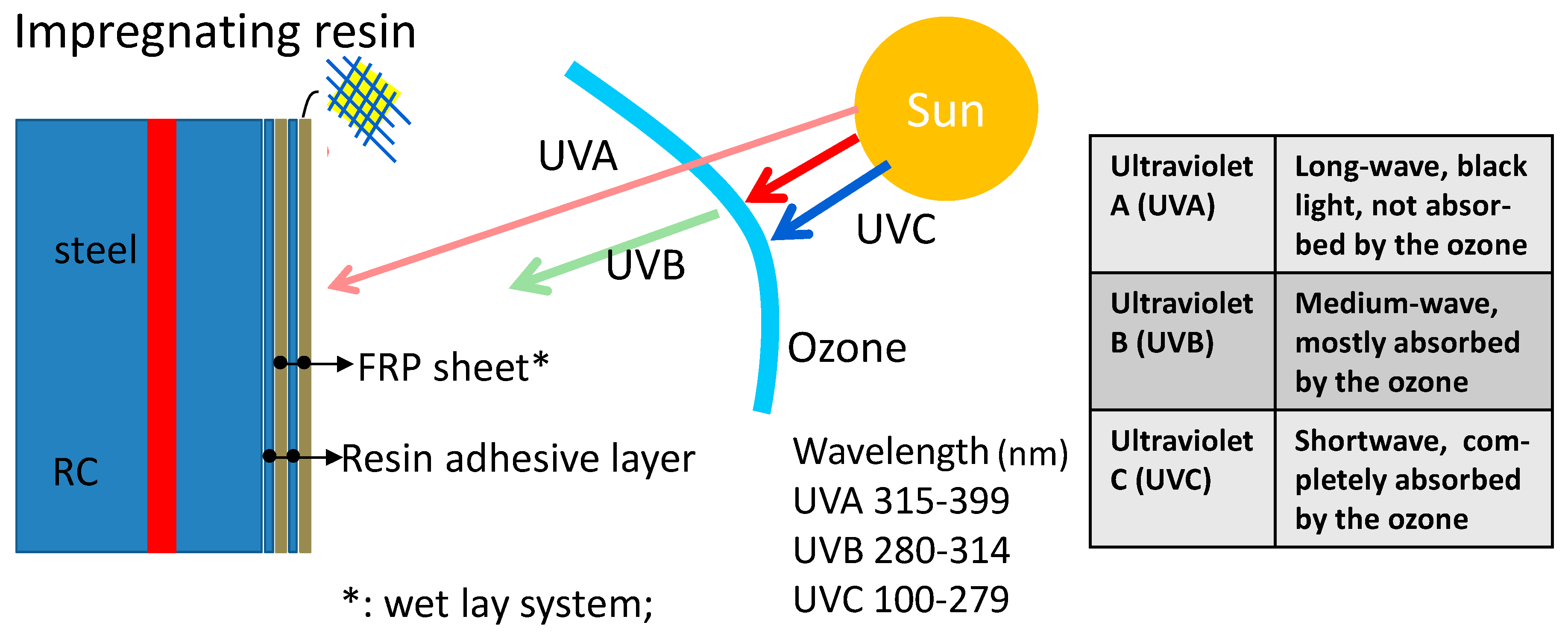
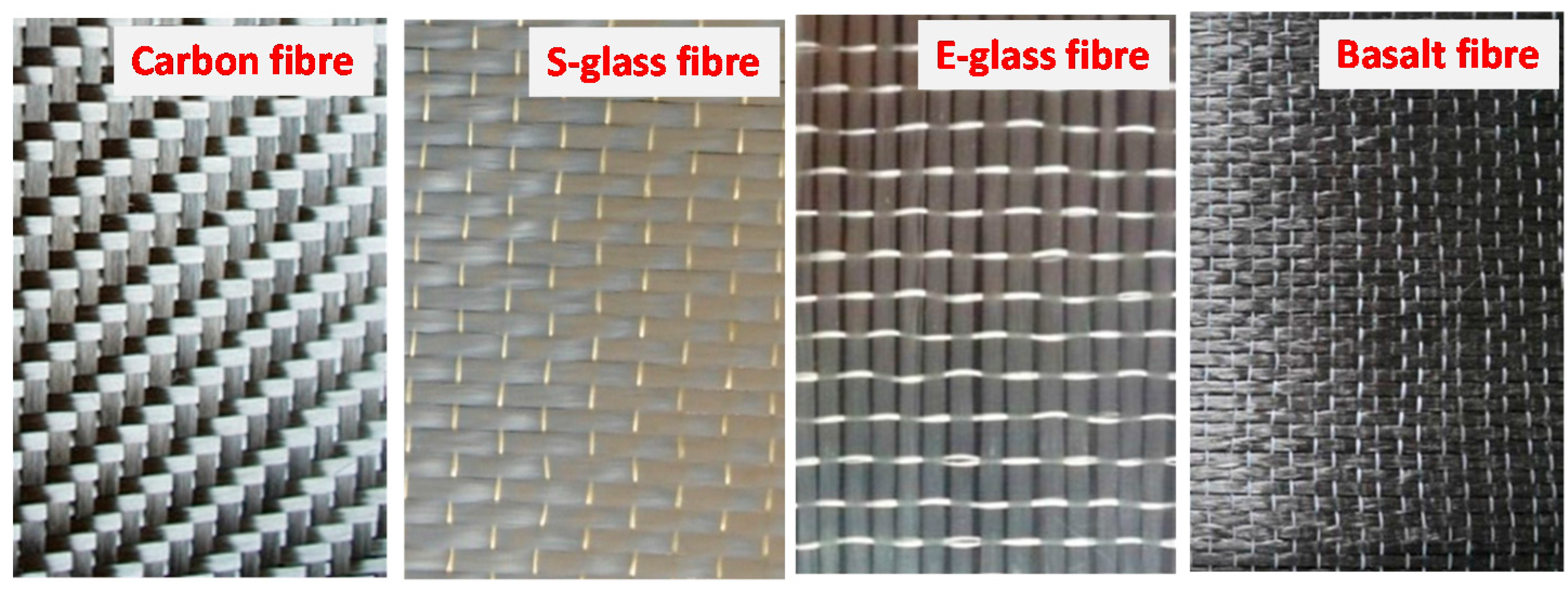


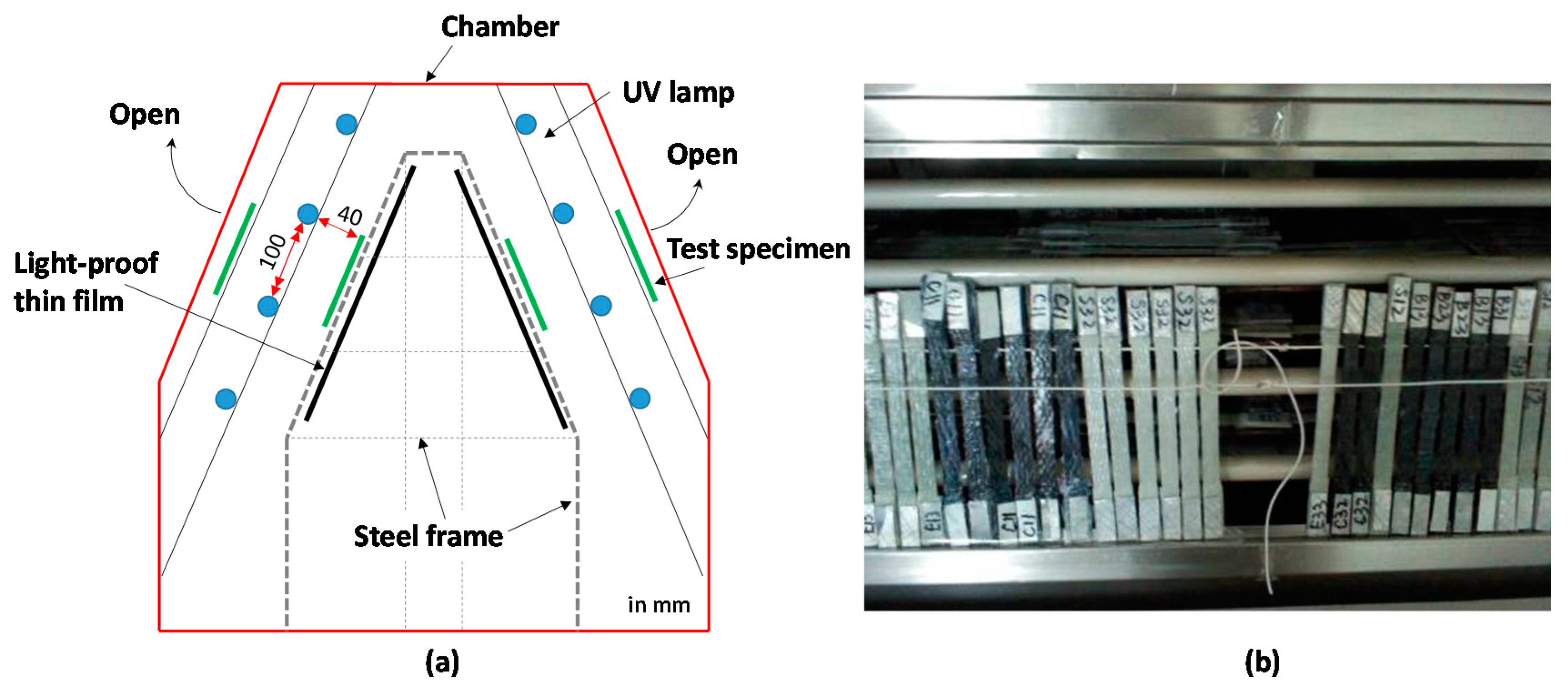
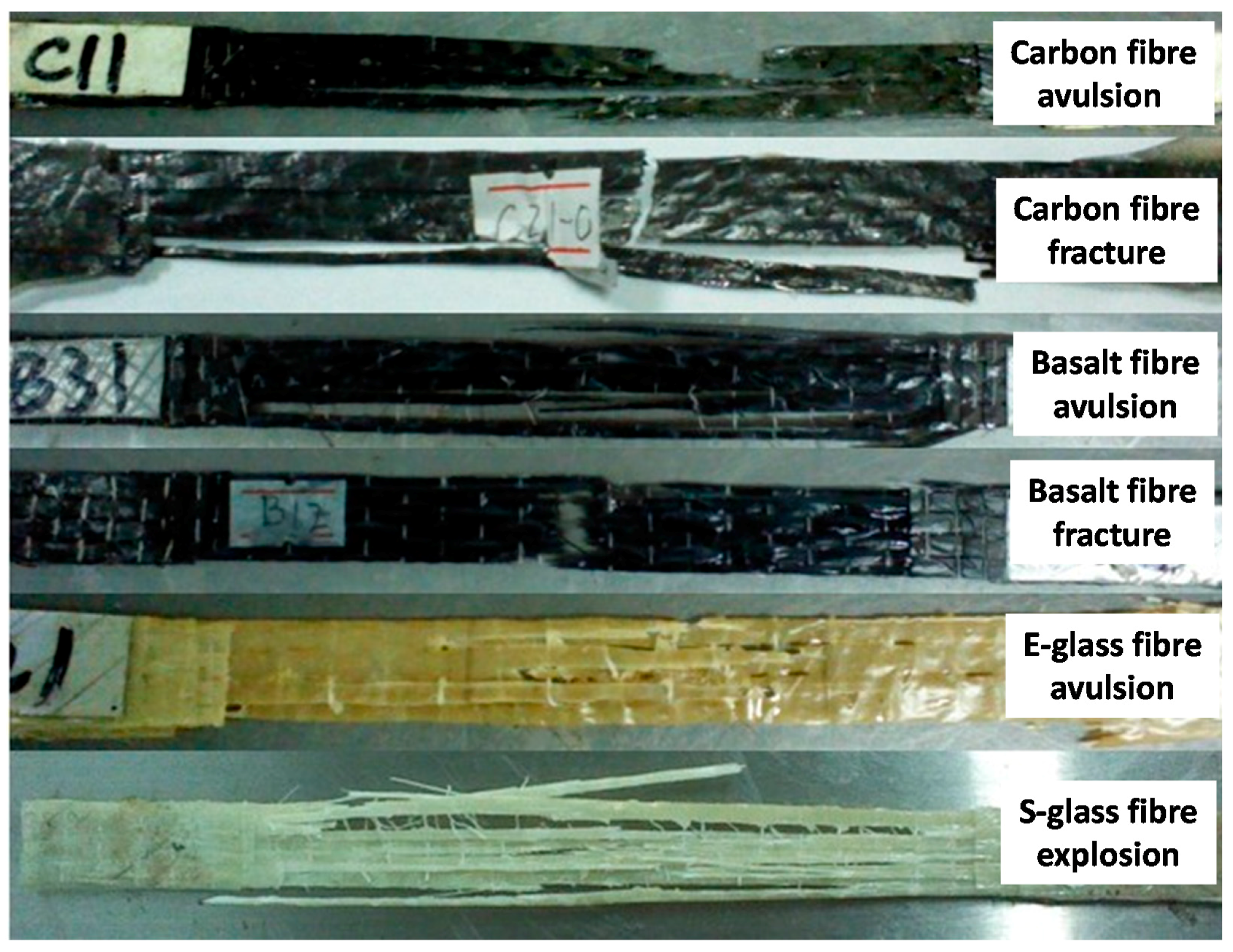


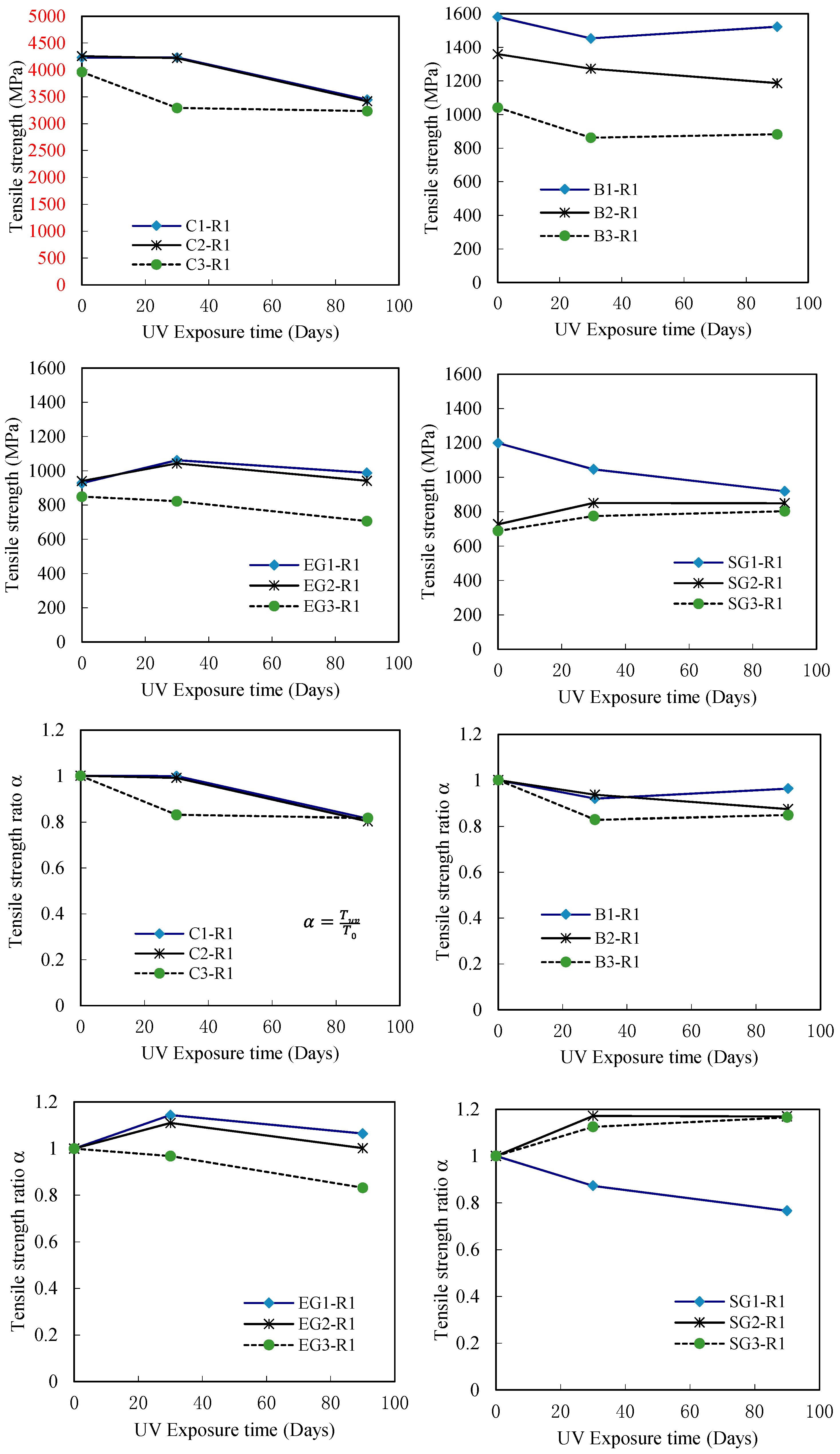
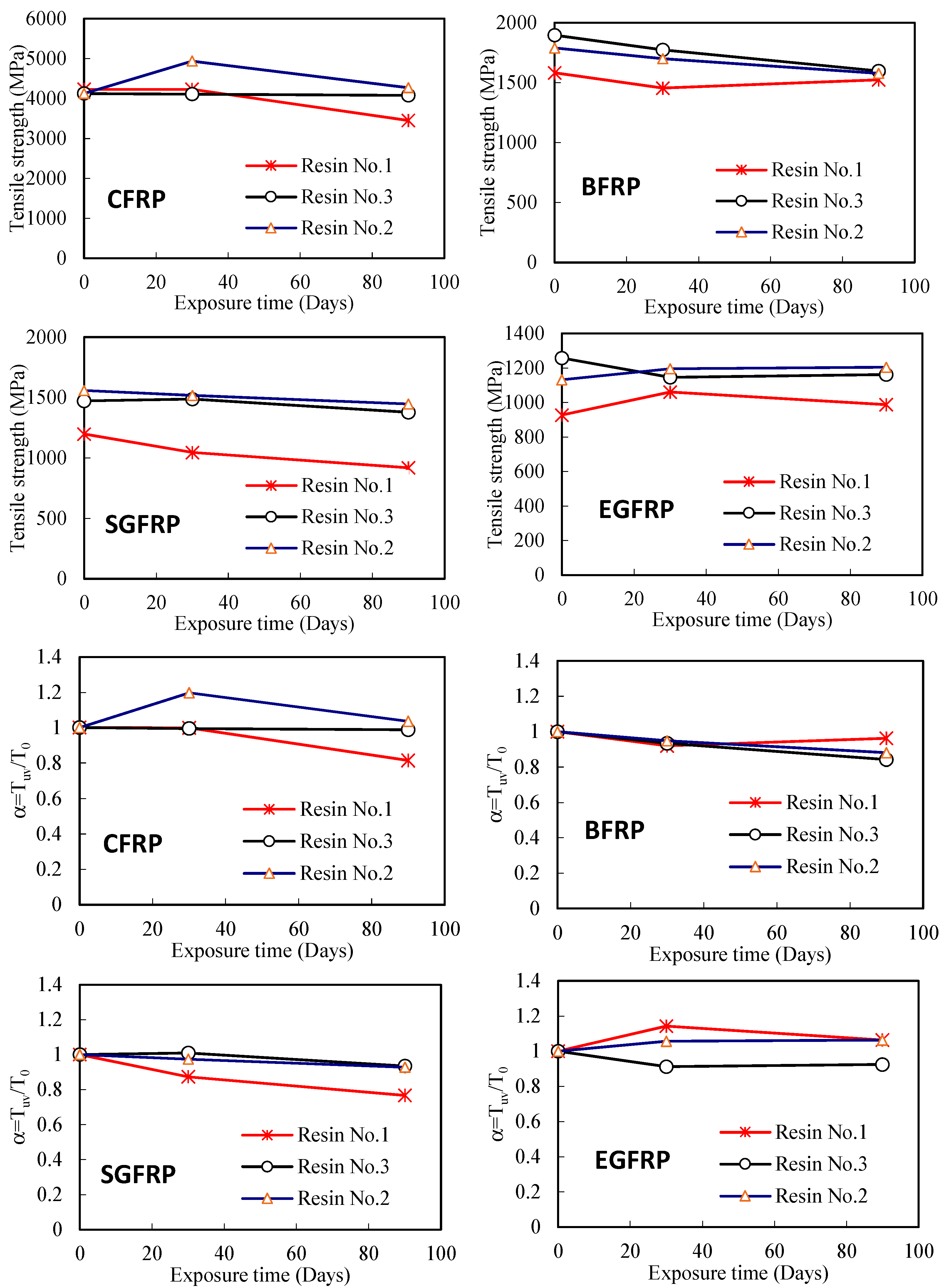

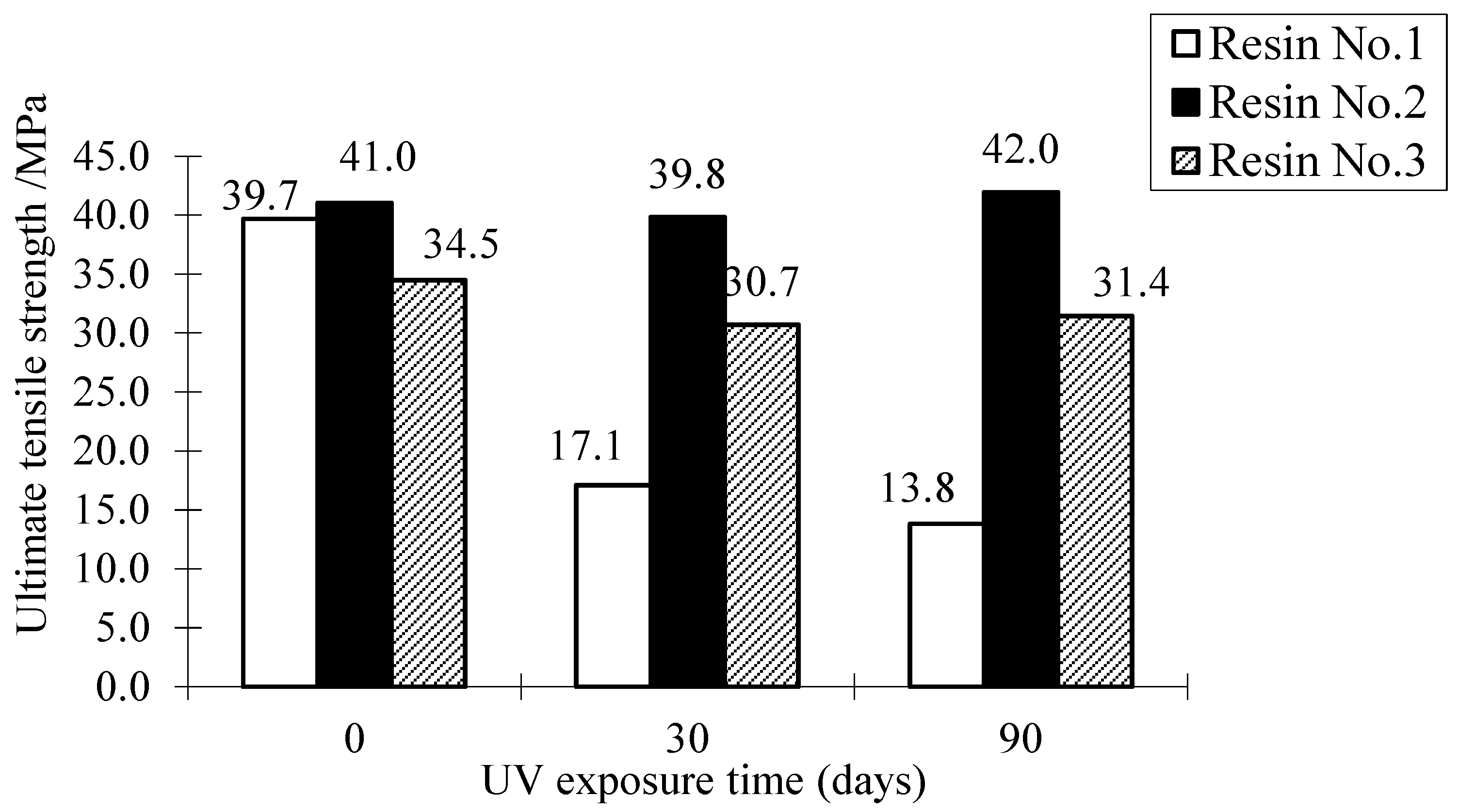
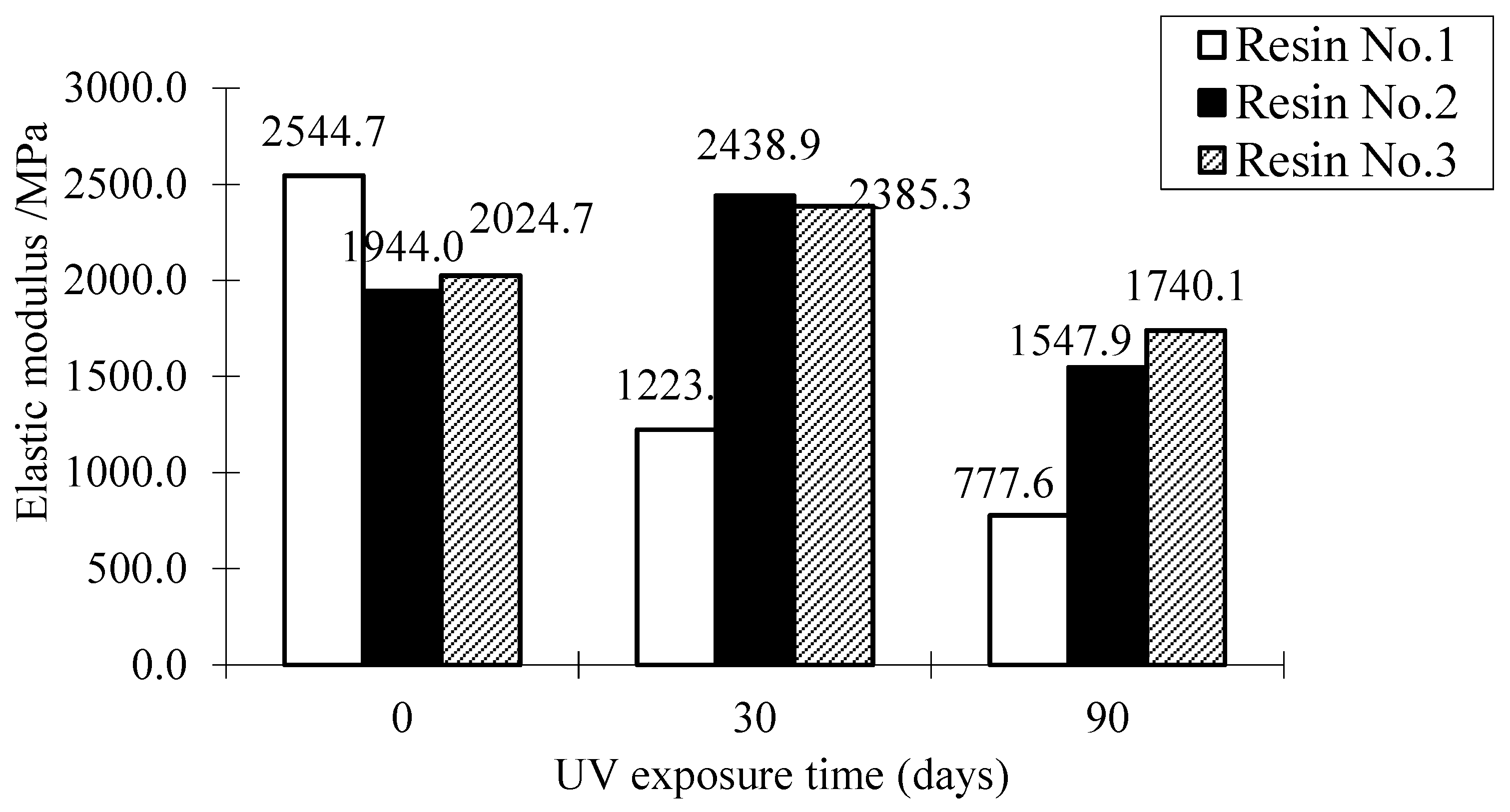
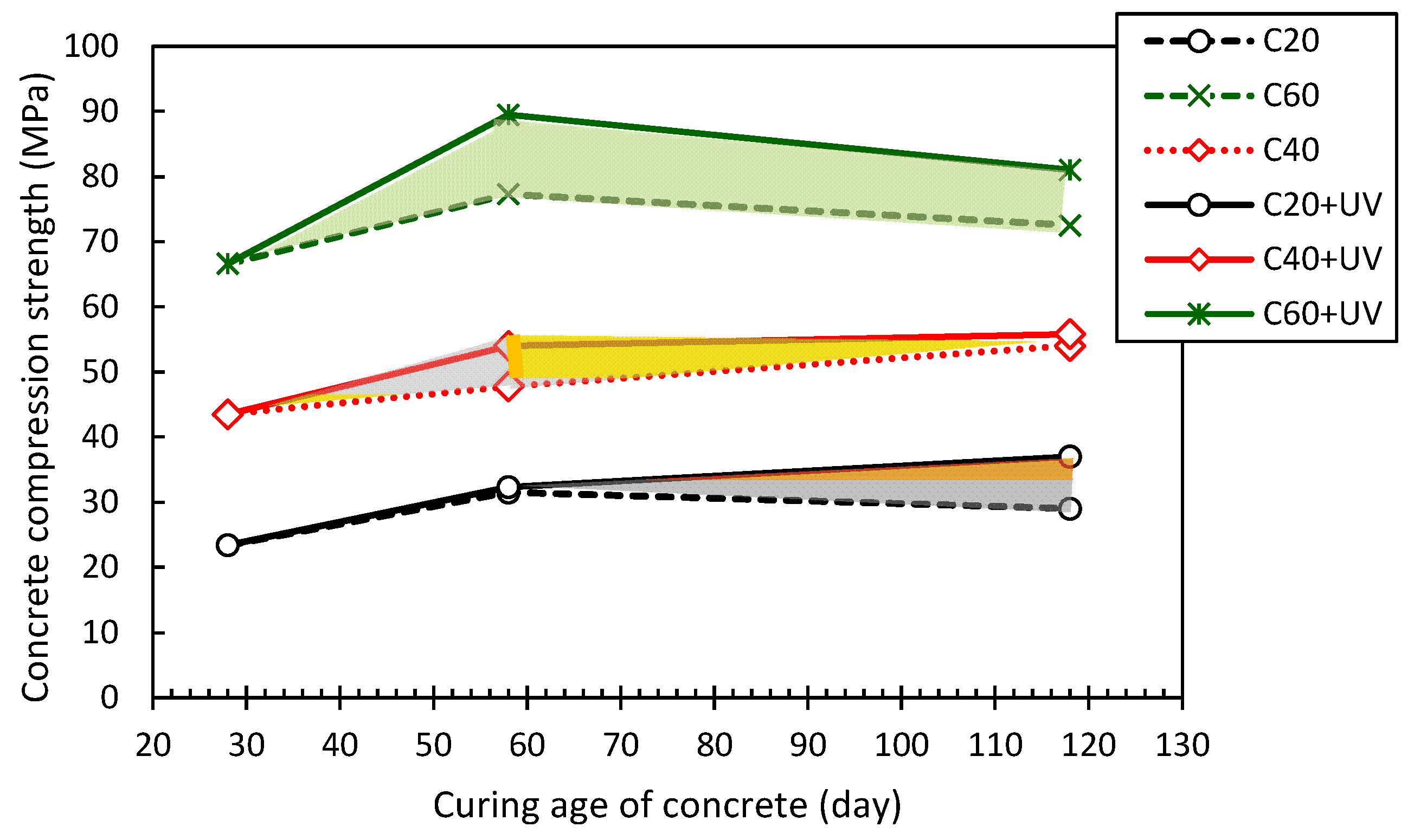
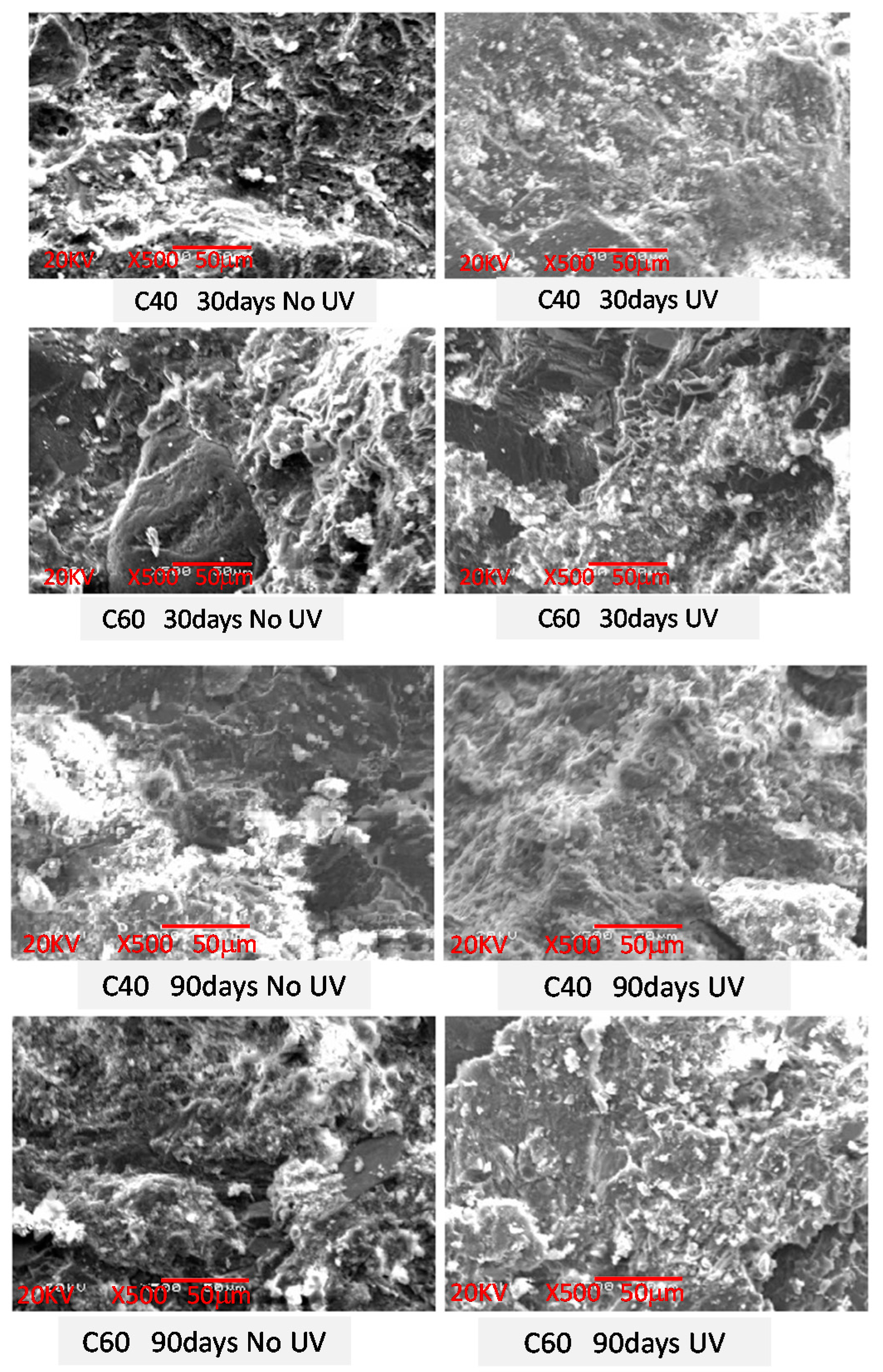
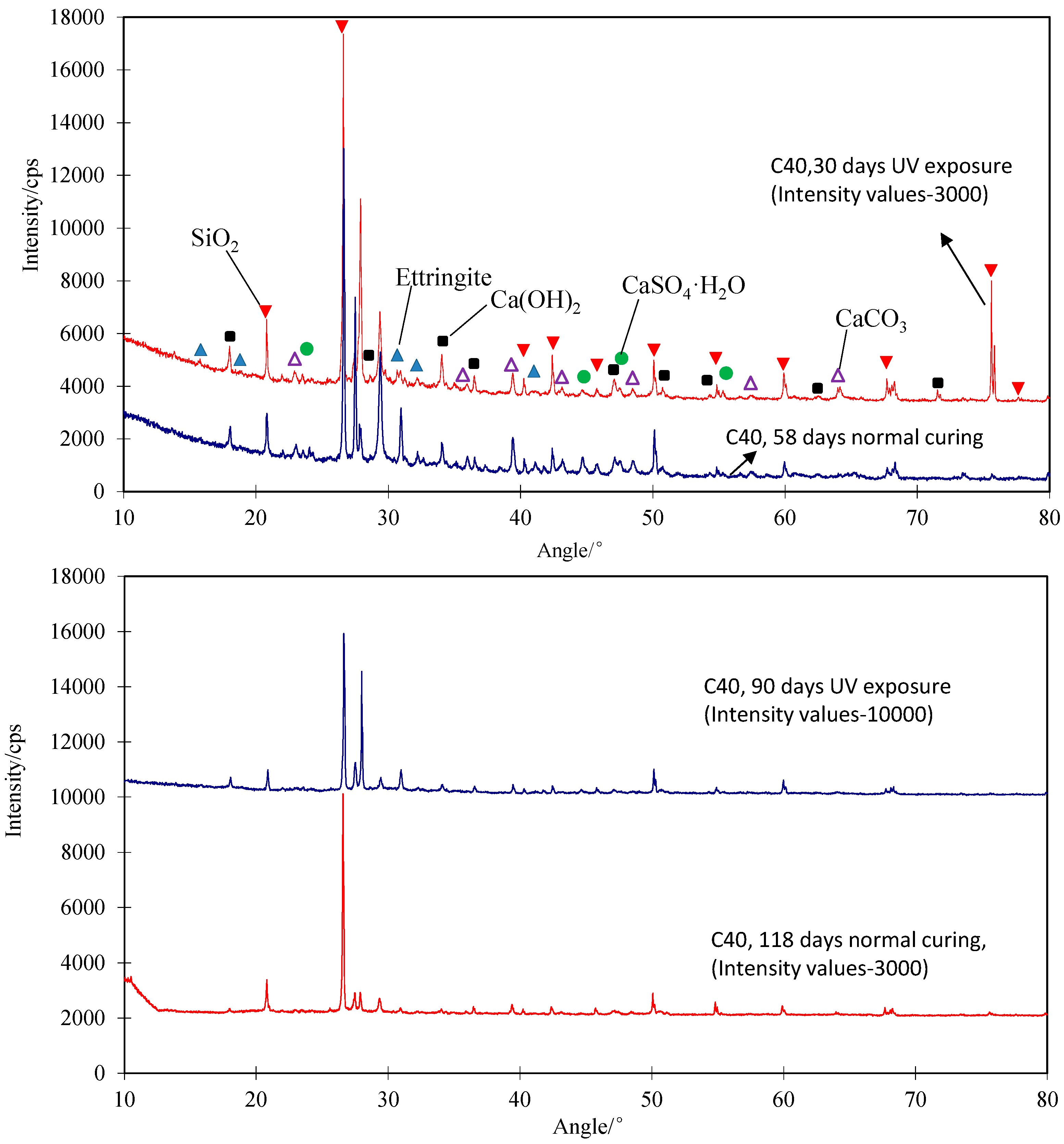
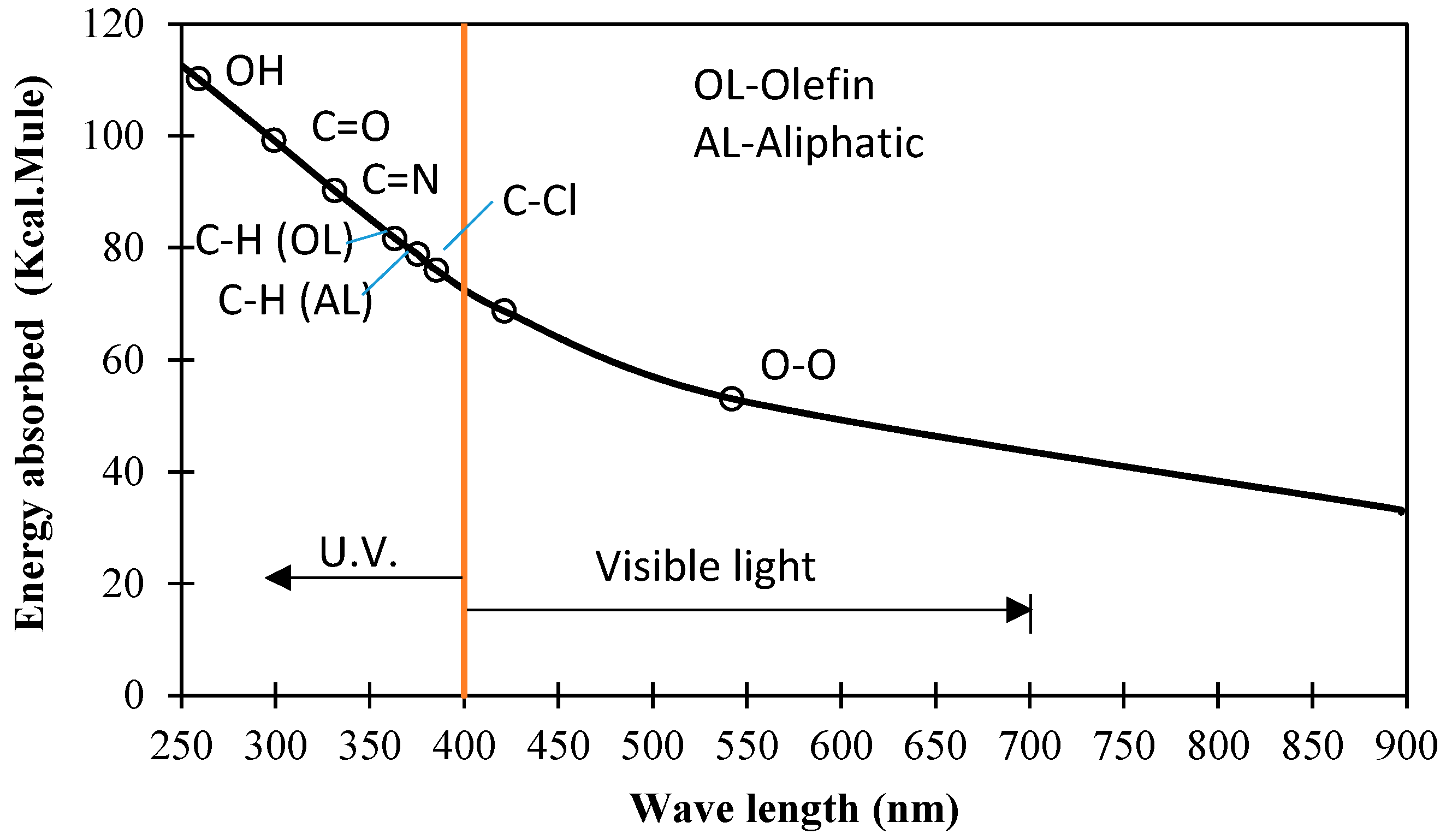
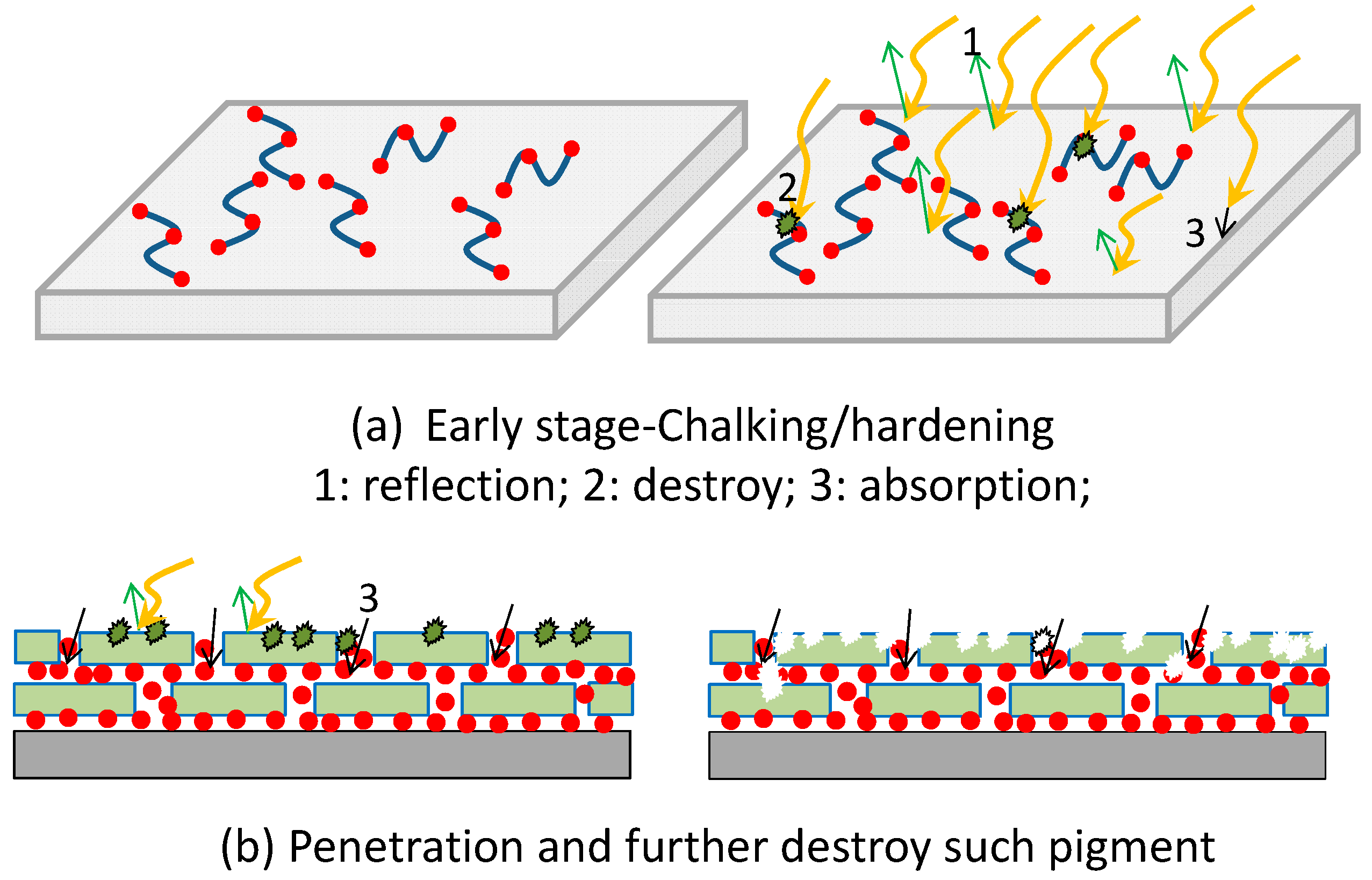
| Properties | Carbon FRP (CFRP) | Basalt FRP (BFRP) | S-Type Glass FRP (SGFRP) | E-Type Glass FRP (EGFRP) |
|---|---|---|---|---|
| Tensile strength/MPa | 3905 | 2335 | 2279 | 1620 |
| Tensile elastic modulus/GPa | 228 | 105 | 106 | 81.4 |
| Ultimate strain/% | 1.67 | 2.1 | 2.76 | 1.49 |
| Nominal thickness/mm | 0.111 | 0.107 | 0.2 | 0.122 |
| Properties | Units | Resin No. 1 | Resin No. 2 | Resin No. 3 |
|---|---|---|---|---|
| VERs + PCAs | Ers + PCAs | VEERs + PCAs | ||
| Ultimate Tensile strength | MPa | 48.6 | 46.4 | 44.3 |
| Elastic modulus | MPa | 2611 | 2620 | 2598 |
| Ultimate strain | % | 1.58 | 1.62 | 1.66 |
| Flexural strength | MPa | 72.4 | 68.3 | 71.2 |
| Compressive strength | MPa | 86 | 76.7 | 74 |
| Bond strength (with concrete) 1 | MPa | 4.6 | 3.4 | 3.9 |
| Shear strength (steel/steel, tensile) | MPa | 18.9 | 15.9 | 16.8 |
| Solid weight ratio | % | 99.4 | 99.4 | 99.4 |
| Check per Chinese code | - | ok | ok | ok |
| No. | w/c 1 | Water (kg/m3) | Cement (kg/m3) | Sands (kg/m3) | Gravels (kg/m3) | WRA 2 (kg/m3) | UV Exposure Time (After 28 Days in Moist Chamber) |
|---|---|---|---|---|---|---|---|
| C20 | 0.6 | 180 | 300 | 689.5 | 1280.5 | 0 | 30/60/90 |
| C40 | 0.45 | 180 | 400 | 654.5 | 1215.5 | 0 | |
| C60 | 0.31 | 180 | 580 | 591.5 | 1098.5 | 11.6 3 |
© 2017 by the authors. Licensee MDPI, Basel, Switzerland. This article is an open access article distributed under the terms and conditions of the Creative Commons Attribution (CC BY) license (http://creativecommons.org/licenses/by/4.0/).
Share and Cite
Zhao, J.; Cai, G.; Cui, L.; Si Larbi, A.; Daniel Tsavdaridis, K. Deterioration of Basic Properties of the Materials in FRP-Strengthening RC Structures under Ultraviolet Exposure. Polymers 2017, 9, 402. https://doi.org/10.3390/polym9090402
Zhao J, Cai G, Cui L, Si Larbi A, Daniel Tsavdaridis K. Deterioration of Basic Properties of the Materials in FRP-Strengthening RC Structures under Ultraviolet Exposure. Polymers. 2017; 9(9):402. https://doi.org/10.3390/polym9090402
Chicago/Turabian StyleZhao, Jun, Gaochuang Cai, Lu Cui, Amir Si Larbi, and Konstantinos Daniel Tsavdaridis. 2017. "Deterioration of Basic Properties of the Materials in FRP-Strengthening RC Structures under Ultraviolet Exposure" Polymers 9, no. 9: 402. https://doi.org/10.3390/polym9090402





